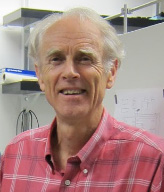Three Crucial Facts Regarding Man-Made Climate Change
In his presentation Dr. Tans discusses what climate scientists do in everyday life, including the development of the NOAA’s CarbonTracker System. He then focused on:
- The observed enhancements of greenhouse gases (GHGs) in the atmosphere are 100% caused by human society.
- The impact of GHGs on the Earth's heat balance can be calculated with high confidence, and
- The GHG enhancements will remain for 1000s of years.
Dr. Tans discussed how much less is known about how the climate system will respond to a changed heat balance, and that the possibility of catastrophic climate change is real. He further addressed how as a society we are aware of actions we can take now to decrease emissions rapidly, which would lower the probability of outcomes that would likely be very hard to deal with.

Dr. Pieter Tans (pieter.tans@noaa.gov) has been actively interested in mankind's influence on climate since he was a student. In 1972, when reading Inadvertent Climate Modification, a report of the study of man's impact on climate, he became convinced that manmade climate change was a problem that was certain to grow in importance over time and decided to change direction from studying solid state physics to earth science. He obtained a PhD from the University of Groningen, The Netherlands, in 1978 studying carbon-14 and carbon-13 in tree rings, which were used to reconstruct the increase of atmospheric carbon dioxide (CO2) since the late 19th century.
Since 1985 he has led the Carbon Cycle Greenhouse Gases Group in the Global Monitoring Division (GMD) of NOAA's Earth System Research Laboratory (ESRL) in Boulder, CO, and discovered the existence of a very large "sink" (uptake) of CO2 by terrestrial ecosystems at mid-latitudes in the northern hemisphere, partially offsetting the emissions caused by the burning of coal, oil, and natural gas. For several decades, his group has maintained a cooperative global atmospheric observing network producing the most widely used data of atmospheric CO2, methane (CH4), carbon monoxide (CO), and several other greenhouse gases and supporting measurements.
In 2007 his group launched CarbonTracker, a global data assimilation system to turn observed spatial and temporal patterns of atmospheric CO2 into spatial patterns of emissions and removals that are optimally consistent with the observations. He invented the AirCore, a very simple system to collect a continuous and vertically resolved sample of air all the way from the mid-stratosphere to the earth’s surface. Most recently, his group has measured emissions (leaks) of methane and other gases from oil and gas fields where hydrofracturing is used.
Education
Webinar Archives Education ResourcesStewardship
Supporting Stewardship Past Projects Focus Area Resources Applying for Funding
Search Education
Get Social
Last updated: 06/16/24
Author: NOAA
How to cite this article
